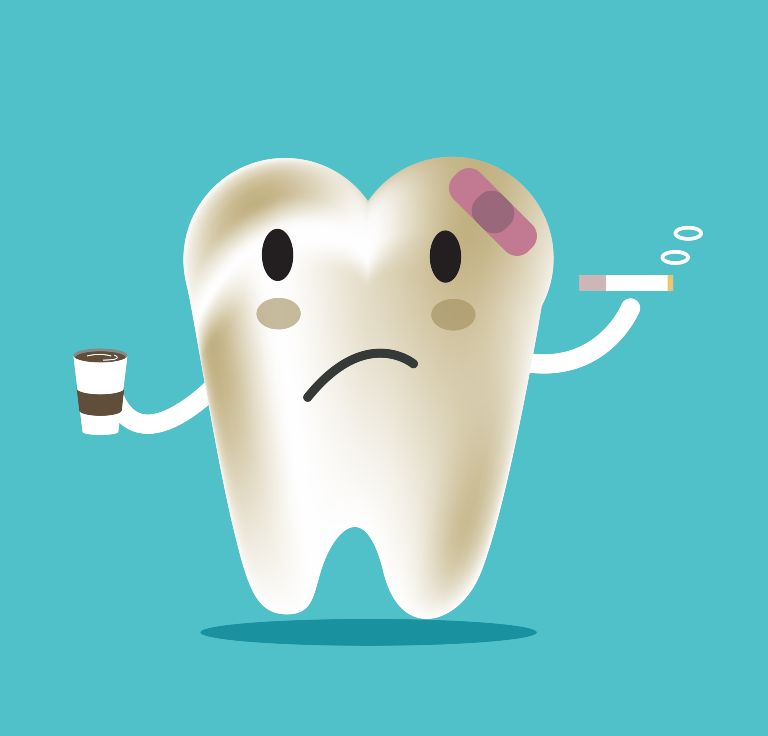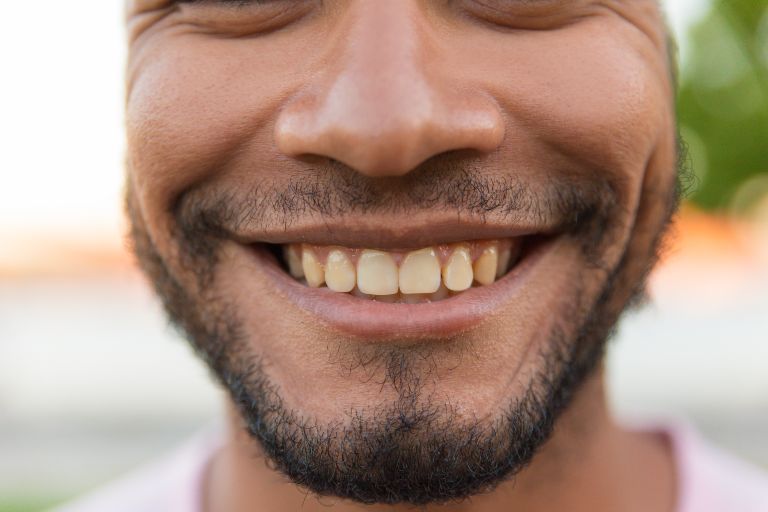There are several things you can do to keep up your dental hygiene, but the bottom line is: smoking will damage and darken your teeth, and brushing and flossing your teeth regularly paired with dental visits are your best options for keeping your smile healthy, strong, and beautiful.
These days it’s common knowledge that smoking harms your body in plenty of ways. The long term effects of smoking tend to be a lot more serious than short term ones. In this article, we’re going to go through what the various harmful effects that smoking has on our bodies are, and then we’re going to zero in a little on exactly how it affects our teeth and how we can undo the damage that smoking does to our teeth.
The number 1 best way to combat the effects of smoke on our teeth is, of course, to quit smoking. That in itself is quite a challenge and something that people struggle with regularly. Through the use of nicotine patches and gum, vape pens, alternative methods, and sometimes just trying to quit cold turkey, people fight the battle to quit smoking every day. The withdrawal symptoms—which can include headaches, irritability, and intense nicotine craving—can make quitting smoking seem even more daunting.
However, within a month of quitting, most of the nicotine receptors in the brain will return back to normal which greatly helps to break the cycle of addiction. Within 2 to 12 weeks of quitting your blood circulation will improve, making physical activity a whole lot easier while lowering the risk of heart attacks. Already within 48 hours of quitting, your nerve endings begin to grow and your sense of taste and smell will begin to improve. Quitting smoking increases your oxygen levels and lowers inflammation, giving your immune system a boost and decreasing the risk of getting sick.
There are many advantages to quitting smoking, but now it’s time to take a look at what smoking does to our bodies.

The first and most severe effect of smoking is death. Smoking takes the lives of approximately 19,000 Australians per year, making it a higher cause of death than HIV, illegal drug and alcohol use or motor vehicle injuries. Smoking causes 90% of lung cancer deaths and 80% of deaths from chronic obstructive pulmonary disease (COPD).
Smokers are double as likely to develop heart diseases and strokes as non-smokers and are 25 times more likely to develop lung cancer. Even people who smoke less than five cigarettes per day are prone to show early signs of cardiovascular disease.
Smoking causes damage to the blood vessels making them thicken and grow narrower, in turn causing the heart to beat faster and raise blood pressure. This increases the risk of clots forming. If a clot blocks the flow of blood to your brain then a stroke occurs. Strokes can also occur if a blood vessel bursts in or around your brain.
Smoking damages your airways and the alveoli (small air sacs) in your lungs, which can result in lung diseases like COPD, emphysema, chronic bronchitis, and lung cancer. If you’re an asthmatic, smoking can trigger an attack or worsen an attack.
Smoking doesn’t only cause cancer in the lungs but increases the possibilities of cancer in the bladder, blood, cervix, colon, rectum, esophagus, larynx, liver, oropharynx, pancreas, stomach, trachea, and bronchus.
Smoking can make it difficult for women to get pregnant as well as increase the possibilities of complications during pregnancy like early delivery, stillbirth, low birth weight, SIDS (sudden infant death syndrome), ectopic pregnancy, and orofacial clefts in infants. It can also adversely affect men’s fertility by damaging sperm.
We’re all aware that smoking is bad for our health, but did you know that smoking is a leading cause of dental problems too? The effects of smoking on teeth and the oral cavity aren’t addressed quite as often as the others, but they are some of the quickest acting effects of all.
The first thing that most people notice is your smile, making the health of your teeth a very important part of an adult’s appearance. Nobody wants a smile with discolored, dull and missing teeth, not to mention a smile that lets out wafts of bad breath. Brushing your teeth regularly is only half of the solution, as it won’t remove stains or halitosis. Frequent dental cleanings can make a world of difference.
Smoking causes stained teeth, a diminished sense of taste, and bad breath. Smoking is one of the most prominent risk factors when it comes to gum disease and periodontal disease, causing inflammation around the tooth. This kind of irritation can also affect the bone resulting in the loss of teeth in the advanced stages.
All in all, smoking and its effects can lead to the decay of your teeth, and make restorative dentistry quite a challenge. The aesthetic results of restorative dental treatments are not always ideal due to heavy discoloration of the tooth caused by tobacco. Not to mention that the recession of your gums can cause uneven margins on crowns or other types of restorations.
The undoubted best way to deal with smoking-related teeth problems is to quit smoking. This will pose other problems, as mentioned above, but will significantly decrease your dental issues and make it a lot easier to maintain a healthy, clean smile.

It isn’t healthy, but it’s very common to have brown spots on your teeth. They may vary in color, ranging from a yellow-brown color to a darker black-brown. The shape and size varies depending on the seriousness, the cause, and the person. Some are more like blotches, while others manifest in lines.
Surprisingly, smoking is not the only thing that causes this kind of discoloration on the teeth. A lot of food and drinks that are dark in color contain chemicals called chromogens. These chemicals tend to stain the enamel on our teeth, like tannic acid in red wine. These stains can become permanent over time, particularly so if the person doesn’t take care of their teeth well and has poor dental hygiene. Artificial dyes and coloring in food and drinks are also factors in stained teeth.
Our mouths house thousands of bacteria which constantly mix with saliva and food particles to make a translucent, sticky film that we call plaque. Brushing and flossing generally keeps plaque levels under control. Failing to do so makes the plaque harden into a coating that’s a little more permanent called tartar or calculus. This tartar is easily discolored and can tend to not only jeopardize the health of your teeth, but also be rather ugly. Smoking, being sick, diabetes, hormonal changes (e.g. puberty, pregnancy, and menopause), and medicine that reduces saliva are all things that contribute to tartar. Only dental professionals will be able to remove tartar once it forms.
The bacteria from plaque and tartar eat the sugars passing through the mouth, and proceed to produce acids than weaken the enamel. These acids adhere to the teeth for long periods of time due to the thick, filmy nature of plaque and tartar.
Cracks in the teeth can let these bacteria creep in and cause decay, causing dark spots and cavities. This kind of decay can lead to the nerve or root being exposed which can be incredibly painful.
Keeping up with your dental hygiene and regularly visiting your dentist is paramount to staying away from these conditions.

Now you may be wondering how to get rid of stains on your teeth. Well the most efficient ways are to brush and floss your teeth every day and take regular trips to the dentist to get your teeth cleaned of plaque and tartar.
But there are also a few things you can try on your own to get rid of dark splotches on your teeth.
Oil pulling is an old traditional Indian remedy used to remove toxins from the body and improve oral hygiene. It involves swishing oil around in your mouth to get rid of bacteria. Originally, sunflower oil is what was used, but any other oil will do the trick. Coconut oil is a good choice since it has a pleasant taste and has a lot of nutrients.
You can also try brushing your teeth with baking soda from time to time. Baking soda is a popular ingredient in commercial toothpaste since it has natural whitening properties. It’s also a mild abrasive that can help scrub the surface of your teeth.
Using hydrogen peroxide can help too since it’s a natural bleaching agent that kills bacteria. It’s been used to disinfect wounds for a long time and many commercial whitening products use it as an ingredient.
Apple cider vinegar is a century-old disinfectant and natural cleaning product. Swishing it around in your mouth from time to time can act as an excellent cleaning agent.

